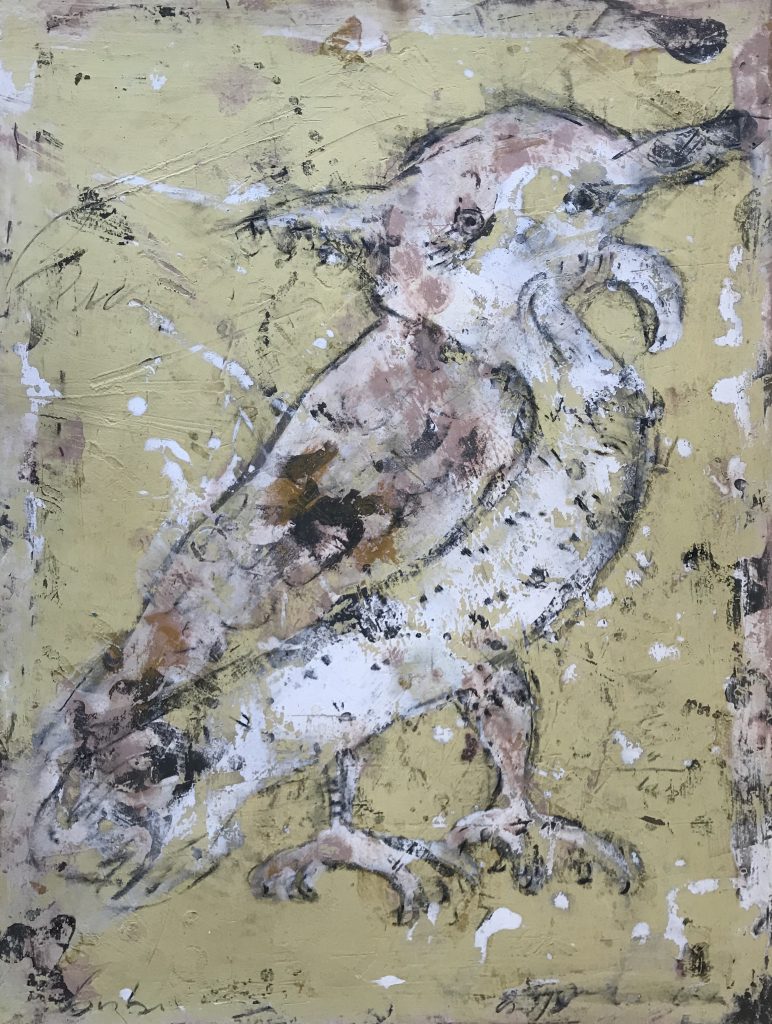Alexis gorodine
(born in 1954)
“Painting as a revealing sign of the magnificent fragility of the world”

Biography
What is the art of painting, when it situates you, as a spectator, in the beating of space and figures brought onto the canvas, on the verge of their vanishing, so that you grasp the paradox between the slow work of painting and the unveiling of specific moments which relate to visions of a world fated to disappear, that is to say arrived at the disturbing of its universal leave, although extraordinarily endowed with beauty? Gorodine’s painting – a legacy of some of Cézanne’s landscapes but also of the extraordinary Unicorn tapestry of the Cluny Museum, which has this magnificent declaration inscribed at its top: “To my only desire” – makes the test and the testimony of the states of a world of which it is proven that we could well feel it and test it only from the transformation of its fragility into catastrophic and exponential dismantling.
Also, this art of painting by GORODINE – animalcules, birds, neighboring creatures in swamps and old groves, landscapes of steps, bordering, inter-zoned – comes to touch me because I perceive it in solidarity continuity with the masterful and poetic horticultural fresco of the Villa Livia, found in Rome, the height of the ancient depiction, composed twenty centuries ago for the major room of an imperial residence, in honor of the rarity of the garden. This painted garden imposed on the spectator a whole apparatus of distance, to show him that the painter’s art is fundamentally at the service of what cannot be grasped and devoured by the Cyclopean empire of seeing, what we could call the ineffable at the same time as the unpresentable. Dimensions of experience far removed from the Roman mentality adapted to jurists, engineers, tradesmen and crowds enslaved to extenuation, who hardly understood the untouchable of invisibility, in other words, what escaped all representation and predation. It took the intervention of an underground Christianity, a less legalistic and more philosophical Judaism, with the renown of the contemplative thought of Plotinus to accompany the end of an outrageously colonizing and materialist empire. The topicality of our globalized capitalist world is ultimately only a replayed continuation of it, of which we know nothing at this time of the obligatory transformation while the signs of collective catastrophe are staring out. We believe do not yet want to see anything! This is why, despite the overwhelming state of things potentially to be seen, since we would be in a society dominated by images, painting is more than ever destined to resist the obligation to make our lives a participation. Generalized digital surveillance. It is not outdated, certainly not, but it belongs to the consequent test of languages called upon to disappear. It is just like the man, today so fragile of his a priori dominant installation, whereas he will have become the exterminator of a multitude of species in a planetary garden of which he cannot see. He will have had it in very bad custody … Painting is therefore never only of imaging force, materialization of what should be represented as an attestation of the powers of seeing, but a work which is unique to this incomparable rythm between the painter’s proposition and the vacancy of the gaze of the one who did not expect to see what comes to light “before his eyes”. This is why Matisse, when he had a course at Montparnasse, told his students to paint the visible from “what they did not see”.
Thus, we can attest that Gorodine continues in our time this privileged practice of painting as that of going beyond control through seeing, to put us back to the intimate and elusive experience of contemplation, always singular and fundamentally resistant to a generalized definition of the role of images. In this, this painting joins the immeasurable. The work, on the other hand, informs us of freedom as an intrinsic resistance to being held and made captive by any trade, including painting itself. It guarantees an openness, a vacancy of the gaze inspired by the work worked in tension between what is manifested and the insistence of an imperious withdrawal which would hold on to the secret’s lack of materialization, decisive and active part …
Gorodine, with the intermediary of his assured profession, arrives at this suspensive state of painting which produces the representation not as a full and closed object, added to the invasion of all the others, but as a test of distance. … This well-conducted painting, a source of delight, has intervened in our life as a participatory sign of the revelation of this magnificent fragility of the world as much as of the unexpected genius of resistance to the powers which claim to bend the irreducible of sensitivity. To these ends, equipped with a profession that has long been tried and tested, served by well-established procedures, Gorodine takes up the centuries-old history of painting, walking in the landscape, without cosmetic excess or boisterous insistence. This is what we love him about.
Every morning, in fact, we resume revisiting with this painting hanging on our domestic picture rails, the banks of the Marne, as “traveled” by our artist. Because his profession grants it to us, it is not only a pictorial transposition of a site that we thus have at the disposal of our daily life, but a reconstituting participation in the singular journey of the author, pledge of a hope in the exception of personal life which is worth living in fraternal sharing of fine sensitivity.
JR.Loth – 14/10/2014
- 5 Quai St-Eienne - 14600 HONFLEUR
- +33 2 31 89 19 13
- +33 6 11 54 54 79
- galeriedaniellebourdette@wanadoo.fr



